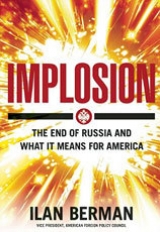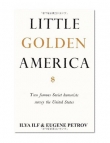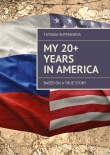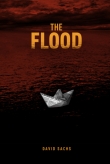
Текст книги "Implosion. The end of Russia and what it means for America"
Автор книги: Ilan Berman
Жанр:
Политика
сообщить о нарушении
Текущая страница: 1 (всего у книги 14 страниц)


THE END OF RUSSIA AND
WHAT IT MEANS FOR AMERICA
ILAN BERMAN

Copyright © 2013 by Ilan Berman
All rights reserved. No part of this publication may be reproduced or transmitted in any form or by any means electronic or mechanical, including photocopy, recording, or any information storage and retrieval system now known or to be invented, without permission in writing from the publisher, except by a reviewer who wishes to quote brief passages in connection with a review written for inclusion in a magazine, newspaper, website, or broadcast.
First ebook edition © 2013
eISBN 978-1-62157-177-3
The Library of Congress has catalogued the hardcover edition as follows:
Published in the United States by
Regnery Publishing, Inc.
One Massachusetts Avenue NW
Washington, DC 20001
www.Regnery.com
Manufactured in the United States of America
10 9 8 7 6 5 4 3 2 1
Books are available in quantity for promotional or premium use. Write to Director of Special Sales, Regnery Publishing, Inc., One Massachusetts Avenue NW, Washington, DC 20001, for information on discounts and terms, or call (202) 216-0600.
Distributed to the trade by
Perseus Distribution
250 West 57th Street
New York, NY 10107
In loving memory of Misha,
my own personal Solzhenitsyn
CONTENTS
FOREWORD
PREFACE: Russia’s Disorder Comes West
CHAPTER ONE: Misreading Russia
CHAPTER TWO: The New Sick Man of Europe
CHAPTER THREE: Muslim Russia Rising
CHAPTER FOUR: Russia’s Hidden War
CHAPTER FIVE: The Far East Flash Point
CHAPTER SIX: Putin’s Crumbling State
CHAPTER SEVEN: Misunderstanding the Muslim World
CHAPTER EIGHT: In Retreat in Asia
CHAPTER NINE: Rebuilding the Empire
CHAPTER TEN: Managing the End of Russia
NOTES
ACKNOWLEDGMENTS
APPENDIX ONE
APPENDIX TWO
INDEX

Credit: Library of Congress
FOREWORD
Ilan Berman’s Implosion: The End of Russia and What It Means for Americais a very important addition to current efforts to think strategically about America and the world.
In the tradition of Herman Pirchner and the American Foreign Policy Council, it looks at Russia and not merely at its president, Vladimir Putin. The combination of his personality, the disciplined ruthlessness of his KGB background, and the temporary advantage of the energy resources in providing a windfall to the Russian state have enabled Putin to occupy a larger space in international relations than the strategic position of Russia would justify.
In many ways we are all still affected by the scale of the Soviet Empire, its toughness in playing the major role in defeating Nazi Germany despite enormous casualties, and its ability to mobilize 20 percent of the economy to build a military machine out of all proportion to its long term capacity (and, one could argue, ultimately bankrupting the country, as had been suggested would happen in 1950 in National Security Council Report 68).
Russia’s relative influence is also helped by its continued possession of one of the world’s two largest nuclear arsenals, its relatively modern arms industry, and the sheer geographic expanse of the country. When you look at a map, you instinctively assume a country that big has to count for something.
Finally, Russia still benefits from being one of the five permanent members of the United Nations Security Council. It inevitably, and at virtually no cost to Moscow, is at the center of the dialogue in international negotiations simply by the historic achievement of having been there at the creation, to borrow Dean Acheson’s term.
The question Ilan Berman puts on the table is whether Russia is a declining power more like the two weaker permanent members of the Security Council (France and Britain) than a true peer of the United States and China.
There are three great advantages to this incisive study.
First, Berman gets one thinking strategically. Not about this week’s posturing in Syria or next week’s press event of Putin posing shirtless next to a dead tiger, but rather thinking beyond Putin about the underlying strategic strengths and weaknesses of the current Russian system.
Second, Berman looks to the roots of any nation’s long-term power capabilities and examines demography and comparative development. Experts have been warning ever since the collapse of the Soviet Empire that Russia is in a deep demographic crisis. Berman walks the reader through the details, and they are very convincing. Alcoholism, abortion, suicide, and emigration are all combining to shrink the Russian ethnic population. At the same time, the Muslim population of Russia is growing. Muslim Russians don’t drink, don’t commit suicide, don’t have abortions, have many children, and have a much more optimistic view of the future than their ethnic Russian counterparts. As Berman notes, Putin’s successors are simply going to have fewer people with a much more difficult ethnic mix to deal with. Russia beyond Putin will inherently be a smaller player on the world stage because it will no longer have the population to be a major one.
This population imbalance will play itself out in two different directions. Internally, the tensions between Muslim and non-Muslim Russians will almost inevitably exacerbate as the energy and youth of the former crowds the aging, declining Russian Christian population. Berman’s recounting of the number of mosques being built in Russia today is in itself a convincing insight into the tensions of the future. Externally, the surging Chinese population will almost inevitably lead to massive Chinese involvement in Asiatic Russia where the Russian population is declining. (A side effect of the end of the Soviet totalitarian system is that a lot of people who were compelled to live in bleak, cold areas are now moving to warmer, more modern areas—and the people in those nicer areas are moving out of Russia to Europe and the United States).
Third, Berman’s last decade has been spent studying radical Islam and its terrorist component and he brings that expertise to bear on Russia’s internal problems. It isn’t just that there will be relatively more Muslims in Russia. The odds are very high that a larger and larger portion of the Muslim population will be attracted to and indoctrinated in a more extreme and more violent aspect of Islam. Because of his unique Russian–Middle Eastern dual specialties, Berman is able to bring together factors many analysts miss.
The primary Russian internal threat is from the radical wing of Sunni Islam. In effect, it is a variant on Wahhabism. This threat is exacerbated by the Russian alliance with the dictatorships in Iran and Syria. Both Russian allies are in the Shi’a camp at a time when the Shi’a-Sunni split may be more bitter and trending toward more violence than any period in recent history. In effect, the Russians may find themselves on the wrong side of an Islamic civil war and that may intensify the efforts outsiders put into radicalizing and militarizing Russia’s own domestic Muslim population.
Berman weaves these patterns together with the corruption of the current regime and its impact on capital and foreign investment fleeing the country. The gap between the authoritarian, criminally penetrated, decaying Russia and the Russia that might have evolved is tragic and has consequences both for individual Russians and for American policy.
I remember visiting the collapsing Soviet Union and early post-Soviet Russia in the early 1990s. Again and again everyday people would say to us, “we just want to become a normal country.” By that they meant a country with the rule of law, opportunity for everyday folks, and a chance to do better economically over time.
As Berman makes clear, that “normal country” was killed off by the oligarchs, organized crime, and the KGB holdovers. The consequences of that failure will limit Russia’s future. That reality should be the baseline for American thinking about strategic planning dealing with Russia.
–Newt Gingrich
Former Speaker of the House
July 7, 2013
PREFACE
RUSSIA’S DISORDER COMES WEST
On April 15, 2013, two bombs went off on Boylston Street, near the finish line of the famous Boston Marathon. The improvised explosive devices, seemingly timed to go off during peak crowd numbers, ripped through the spectators, killing three and injuring more than 250 others in the largest terrorist incident to take place on U.S. soil since the attacks of 9/11.
In the days that followed, a massive dragnet by law enforcement authorities netted two perpetrators of Chechen extraction: twenty-six-year-old Tamerlan Tsarnaev and his nineteen-year-old brother, Dzhokhar. The resulting showdown left the former dead and the latter hospitalized and awaiting justice in the U.S. legal system.
Speculation has abounded about the motivations that led the two brothers to carry out their brazen act of terror. By all accounts, both were homegrown radicals, albeit ones who had received inspiration, and perhaps even dangerous instruction, from ideologues abroad. But at least in some measure, the roots of the Tsarnaevs’ militancy can be traced back to Russia’s long-running struggle against radical Islam—a phenomenon that, two decades after the collapse of the USSR, has begun to emerge as a threat to the West.
It is also a foretaste of things to come. Today, the once-mighty Russian state is crumbling under the weight of its own internal contradictions. A rising tide of Islamic radicalism is only one sign of this disorder. Others include population decline on a catastrophic scale, as well as growing strategic competition with neighboring China. As these trends consume Russia, the reverberations will be felt far beyond its borders, including here in the West.
But we should start with a word of caution. History teaches us that nothing is inevitable. Prognosticating about the future is a seductive pastime, and more than a few foreign policy analysts have tried their hands at it over the years. Their track records, however, suggest that such prophesying is an occupation better left to fortune-tellers and clairvoyants.
This book, then, isn’t about the certain collapse of Russia. It’s easy to imagine that the country might indeed be able to muddle through the coming decades, despite the mounting pressures now taking shape within its borders.
Rather, it’s about the end of Russia as we know it. Today, the Russian state is on the cusp of a monumental transformation, brought about by demographic decline, radical (and rapid) ethnic and sectarian change, and a profound shift in the geopolitical balance of power between it and its sometime ally, China. Left unaddressed, these trends will transform the very nature of the Russian state and will do so in ways that will have global implications—including for the United States, which still dominates the Russian imagination as a measure of their own worth and as a strategic adversary.
The changes outlined in the pages that follow could well lead to Russia’s outright collapse. However, they might not. One thing is for certain: the Russia that America will have to contend with tomorrow will look very different than the one we see today. Today’s Russia is quickly becoming a thing of the past.
CHAPTER ONE
MISREADING RUSSIA
The year is 2040, and Russia is virtually unrecognizable. Decades of population decline and societal malaise have eaten away at the once-mighty Russian state, leaving it a shadow of its former self. Domestically, the country is undergoing a massive social upheaval, as the country’s dwindling and increasingly nationalistic Slavic population wages what amounts to a civil “cold war” with an expanding, and radicalizing, Muslim underclass. Separatist tendencies are on the rise in the country’s majority-Muslim republics. Some have had to be forcibly prevented from breaking away from the Russian state, while others are planning for just such an exit, despite threats (and payoffs) from Moscow. Violent attacks by domestic Islamist extremists and foreign jihadistshave become commonplace—scaring away tourists and discouraging foreign investment. Desperate to maintain order, the Russian government has resorted to widespread, sustained repression of a sort not seen since the days of the Soviet Union, further radicalizing the government’s political opponents and isolating Russia from the West.
Meanwhile, the territory of the Russian Federation looks dramatically different than it did just twenty years before. Decades of Slavic depopulation and stealthy Chinese immigration have made Beijing the de factooverlord of Russia’s resource-rich Far East. Russia no longer has any hope of emerging as an Asian political and economic power. China has displaced it, and Russia has tried to compensate with territorial conquest in the post-Soviet space, absorbing Belarus and embarking on a series of costly (and unresolved) military conflicts with Ukraine and other countries on its immediate periphery.
In Washington, officials have begun to raise a number of grim questions: Could jihadistforces seize control of Russia’s nuclear weapons? Might Russia try to buy off Islamists by selling nuclear weapons to Muslim countries? How should the United States and other Western powers react if Moscow overtly threatens Eastern Europe and the Caucasus? If Russia and China go to war in the Far East, should the United States intervene? And if Russia collapses into internal chaos, will Washington be forced to come to its rescue, economically or militarily, or both?
The year 2040 is only some twenty-five years away, and while the scenarios outlined above are by no means inevitable, they are, as we will see, quite plausible.
THE BEAR IS BACK . . . FOR NOW
For the moment, the unraveling of Russia is still far from the minds of most observers. In fact, Russia’s future looks comparatively bright. While the decade that followed the Soviet Union’s collapse in 1991 saw a Russia that was humbled and diminished, over the past dozen years it has roared back onto the international stage under the guidance of its current president, Vladimir Putin.
In the Middle East, Moscow has reverted to familiar Soviet-style balance-of-power politics. It has played a key role in propping up the regime of Bashar al-Assad in Damascus, prolonging the brutal war that is being waged by Syria’s dictator against his own people. 1Russia likewise remains an enabler of Iran’s nuclear ambitions, providing political cover and crucial know-how to the Islamic Republic’s atomic effort despite deepening international concerns. 2
Moscow has similarly divided and conquered in Europe. Its brief but decisive 2008 war with neighboring Georgia succeeded in halting the eastward expansion of the North Atlantic Treaty Organization (NATO), a key post–Cold War goal of both Europe and the United States. More than a few European countries, meanwhile, have become the targets of Russian economic blackmail, with the Kremlin using its energy wealth to shape politics there. 3
In its “near abroad” of Central Asia and the Caucasus, Moscow has managed to regain a lot of its lost stature. Over the past decade, it has reconstituted much of its former influence through the construction of new political blocs, such as the Collective Security Treaty Organization and Shanghai Cooperation Organization, and by manipulating the region’s fragile regimes. At the same time, it has worked diligently to shoulder the United States out of important post–September 11 military basing arrangements and reemerge as the unquestioned power in the post-Soviet space. 4
Russia’s return to global prominence has been engineered by Vladimir Putin, who, since his ascent to power in the last days of 1999, has taken Russia in a dramatically different direction from his predecessor, Boris Yeltsin.
During the Yeltsin era, Russia had become known as the “wild east,” a place where gangster capitalism ran amok, 5organized crime was ubiquitous, 6and worries abounded over the security of the country’s vast nuclear arsenal. 7But it also saw the rise of real pluralism and open political debate.
Putin, by contrast, has exploited weariness with economic instability to concentrate power in a repressive, centralized state. Putin’s authoritarian regime rules by political fiat, rewards loyalists through a vast network of corruption, and cows its political opponents into silence. 8It simultaneously maintains its popularity through nationalistic posturing. Two decades after the Soviet collapse, Russia is ruled by a government that is consumed with its own financial well-being and global status but neglectful of the long-term needs of its people.
Not surprisingly, military modernization has become a central plank of Putin’s agenda. Over the past decade, the Russian government has made major investments in its strategic forces with the aim of building a “twenty-first-century nuclear arsenal” that can overwhelm missile defenses and threaten the West. 9This effort has included the creation of new intercontinental ballistic missiles, the deployment of additional long-range strike capabilities, and serious work on electromagnetic pulse weapons, with an additional estimated $600 billion to be spent on improving Russia’s military capabilities through the end of the decade. 10
Russia has done this even as the United States has sought to reduce its own capabilities. Since coming to power, the Obama administration has consistently advocated the total elimination of nuclear weapons, a concept colloquially known as “global zero,” and made significant reductions to America’s strategic arsenal in pursuit of that objective. President Obama’s second term will include still more such cuts. 11
The goal of Putin’s policies is to reclaim Russia’s geopolitical greatness. In 2005, in his annual state of the nation address to the Russian parliament, Putin referred to the collapse of the Soviet Union as the “greatest geopolitical catastrophe” of the last century. 12Putin’s comments created a firestorm in the West, where memories of the “Evil Empire” are still fresh. But at home, his words resonated with many Russians. It’s easy to see why; an October 2012 survey conducted by the Carnegie Endowment for International Peace found that a third of Russians polled approved of or admired former Soviet dictator Joseph Stalin, while an equal number said that Russia needs a strong ruler like him. Support for Stalin had actually increasedsince the end of the Soviet Union. Surveying these discouraging results, Russia expert Masha Lipmann concluded that the “Russian people still have not come to terms with Stalin’s legacy.” 13
Nor have they abandoned the idea of their country’s destiny as a great power. This concept, known as derzhavnost, has animated Russian politics for centuries, driving successive czars to wage wars of conquest to expand the territories under their rule. Today, Putin’s government has harnessed derzhavnostin its efforts to create a neo-Soviet sphere—a post-modern empire of extended Kremlin influence (if not actual territorial control). 14
Russia likewise has demonstrated a growing willingness to challenge America strategically. Even as policymakers in Washington have sought to “reset” political relations with Moscow, the Russian government has revived a corrosive brand of anti-Americanism that views the United States as Russia’s “main enemy” and geopolitical rival. Russia’s more aggressive stance toward the United States was evident in 2012 when it twice violated the territorial sovereignty of the United States by carrying out aerial maneuvers inside the U.S. air defense zone. The moves were shockingly reminiscent of Soviet provocations during the Cold War. 15
THE REAL THREAT FROM RUSSIA
In crafting their policies, Western governments have taken for granted that Russia, once weak, is now resurgent and that Moscow must be accommodated, or at least engaged.
Yet, for all of the Kremlin’s current geopolitical posturing, Russia’s revival will be fleeting, because the Russian Federation is fast approaching a massive social and political upheaval that promises to be as transformative as the USSR’s demise some two decades ago. Russia’s coming crisis is driven by the convergence of three trends:
Russia is dying. Russia is undergoing a catastrophic post-Soviet societal decline due to abysmal health standards, runaway drug addiction, and an AIDS crisis that officials have termed an “epidemic.” The population of the Russian Federation is declining by close to half a million souls every year due to death and emigration. At this rate, the once-mighty Russian state could lose a quarter of its population by the middle of this century. And according to some projections, if Russia’s demographic trajectory does not change, its population could plummet to as little as fifty-two million people by 2080. 16It’s a phenomenon demographers have described as “the emptying of Russia”—a wholesale implosion of Russia’s human capital and a collapse of its prospects as a viable modern state. 17
Russia is transforming. Russia is experiencing a radical change in its ethnic and religious composition. Today, Russia’s estimated twenty-one million Muslims are still a distinct minority. But Muslims are on track to account for a fifth of the country’s population by the end of this decade, and a majority by mid-century. 18Such a demographic revolution will fundamentally change Russia’s character. That is not a problem, per se. But in recent years, the Kremlin has discriminated against its Muslim minority and ignored (even abetted) the rise of xenophobia among its citizens. This has bred resentment and alienation among Russia’s Muslims, sentiments that radical Islamic groups have begun to exploit. The result is an increasingly restive Muslim minority with little connection to—or love for—the Russian state.
The Chinese are coming. A decline in Russia’s population east of the Ural Mountains and a loosening of Kremlin control over the country’s resource-rich east has sharpened the strategic competition with neighboring China and brought long-buried tensions over the future of the region back to the surface. In this unfolding conflict, China, a rising global economic and strategic power, holds the upper hand over a declining Russia. And, because it does, China could soon grow bold enough to challenge Russia for dominion over the latter’s economically vital eastern territories.
WHY RUSSIAN WEAKNESS MATTERS
This perfect storm of demographic change, religious transformation, and external pressure will determine Russia’s internal political climate, its place in the world, and its future strategic priorities.
Russia’s revival will cause short-term tactical problems for the United States and its allies in the West. But further into the future, the strategic challenge posed by Russia will be even more profound. If the twentieth century was defined in large part by the rise of Russia (in the form of the Soviet Union), the twenty-first will be shaped in great measure by its unraveling.
This book is about that decline and its logical end product: the end of Russia itself. To be sure, the Russian Federation might not cease to exist altogether. In fact, it may yet linger on for some time to come. But the economic and social indicators are unmistakable: the Russia of tomorrow will look radically different from that of today. And when it does happen, Russia’s implosion will threaten the United States and American interests in new and grave ways.
Policymakers in Washington would be wise not only to understand this reality, but also to begin planning for it.








